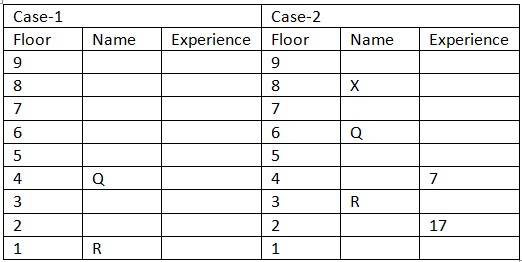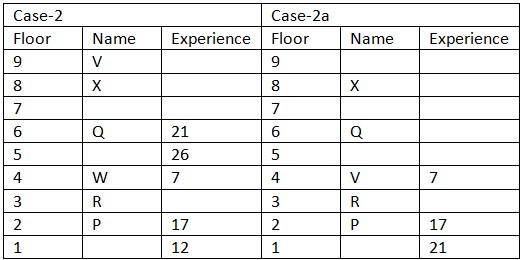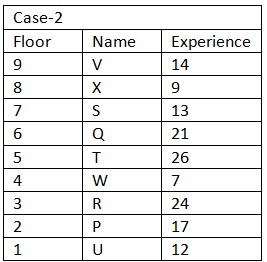Question
What is the sum of the experience of the persons living
on floor numbers 6, 4, and 1? Study the following information carefully and answer the below questions. Nine persons namely – P, Q, R, S, T, U, V, W, and X live in a nine floored building marked 1 to 9 from bottom to top. Each person has different working experience viz.- 7, 9, 12, 13, 14, 17, 21, 24, and 26. All the information is not necessary in the same order. Note: The experience of the persons living on the adjacent floor is neither a common factor nor a common multiple. Q lives on an even number floor. R, who lives on any floor below floor number 4, lives three floors away from Q and doesn’t have experience of 12 years. W lives on any floor above the one whose experience is 12 years but not adjacent to Q’s floor. Neither Q nor R lives on the adjacent floor of X, who lives four floors away from the one whose experience is 7 years. V lives three floors above the one whose experience is 21 years. The number of persons living between Q and X is the same as the number of persons living below P, whose experience is 17 years. The number of persons living between V and the one whose experience is 26 years is one more than the number of persons living between the one whose experience is 12 years and W. Experience of X is neither 26 nor 14 years. The one whose experience is 14 years lives two floors away from S. The number of persons living between S and Q is the same as between S and the one whose experience is 9 years. W doesn’t live on the topmost floor. U has less experience than T.Solution
Q lives on an even number floor. R, who lives on any floor below floor number 4, lives three floors away from Q and doesn’t have experience of 12 years. That means, in case (2) Q lives on floor number 6, in case (1) Q lives on floor number 4. Neither Q nor R lives on the adjacent floor of X, who lives four floors away from the one whose experience is 7 years. The number of persons living between Q and X is the same as the number of persons living below P, whose experience is 17 years. That means, in case (2) X lives on floor number 8, case (1) is not valid. Based on the above given information we have:  Case (1) is not valid as the number of persons living between Q and X is the same as the number of persons living below P, whose experience is 17 years. Again, we have: V lives three floors above the one whose experience is 21 years. That means, in case (2) V lives on floor number 9, in case (2a) V lives on floor number 4. The number of persons living between V and the one whose experience is 26 years is one more than the number of persons living between the one whose experience is 12 years and W. The experience of X is neither 26 nor 14 years. W lives on any floor above the one whose experience is 12 years but not adjacent to Q’s floor. W doesn’t live on the topmost floor. That means, in case (2) the one whose experience is 12 years lives on floor number 1, case (2a) is not valid. Based on the above given information we have:
Case (1) is not valid as the number of persons living between Q and X is the same as the number of persons living below P, whose experience is 17 years. Again, we have: V lives three floors above the one whose experience is 21 years. That means, in case (2) V lives on floor number 9, in case (2a) V lives on floor number 4. The number of persons living between V and the one whose experience is 26 years is one more than the number of persons living between the one whose experience is 12 years and W. The experience of X is neither 26 nor 14 years. W lives on any floor above the one whose experience is 12 years but not adjacent to Q’s floor. W doesn’t live on the topmost floor. That means, in case (2) the one whose experience is 12 years lives on floor number 1, case (2a) is not valid. Based on the above given information we have:  Case (2a) is not valid as W lives on any floor above the one whose experience is 12 years but not adjacent to Q’s floor and W doesn’t live on the topmost floor. Again, we have: The one whose experience is 14 years lives two floors away from S. U has less experience than T. The number of persons living between S and Q is the same as between S and the one whose experience is 9 years. Since, persons whose experiences are in common multiple are not living on the adjacent floor. This, the experience of S is 13 years. Based on the above given information we have
Case (2a) is not valid as W lives on any floor above the one whose experience is 12 years but not adjacent to Q’s floor and W doesn’t live on the topmost floor. Again, we have: The one whose experience is 14 years lives two floors away from S. U has less experience than T. The number of persons living between S and Q is the same as between S and the one whose experience is 9 years. Since, persons whose experiences are in common multiple are not living on the adjacent floor. This, the experience of S is 13 years. Based on the above given information we have 
- In which state is the Tobacco Board's main office located?
- Who is known in India as the 'Bharat Kumar'?
Which gas is most abundant in the Earth’s atmosphere?
- Which European nation appointed Duro Macut as Prime Minister in April 2025?
Match the following crops with their highest-producing states in India:
Which of the following statements about the export ban on non-basmati white rice is correct?
1. The ban was imposed in July 2023 to control domes...
What is the currency of Japan?
- Which of the following statements is/are true?
(I) India, Pakistan, and China followed similar development planning models.
(II) India undertook stru... Who has been appointed as the brand ambassador of Fit India Movement in February 2024?
Which of the following pairs is correctly matched?
Relevant for Exams:


